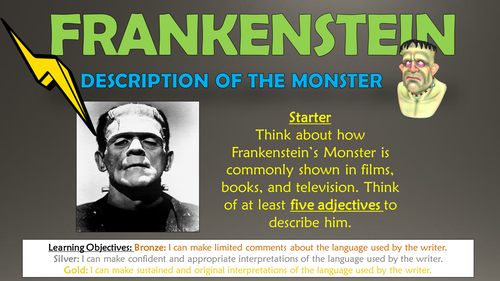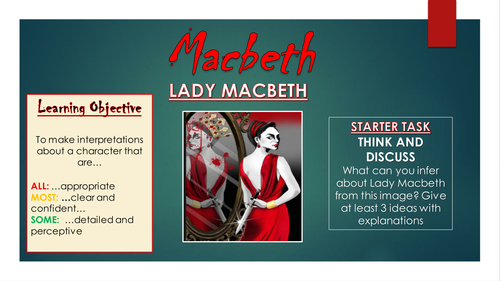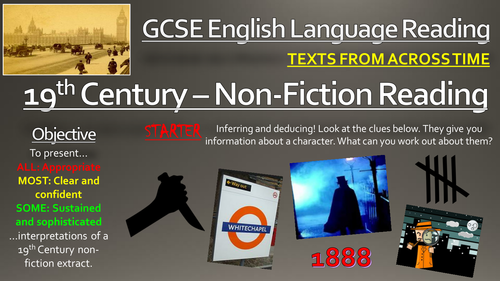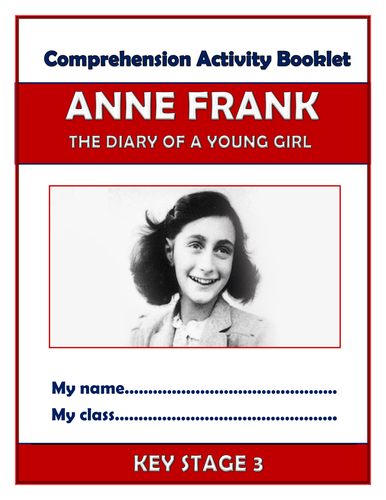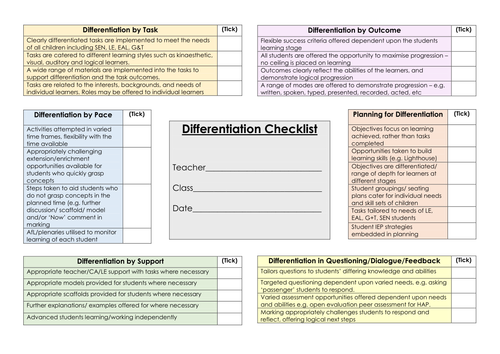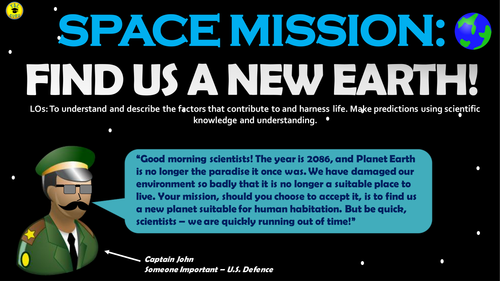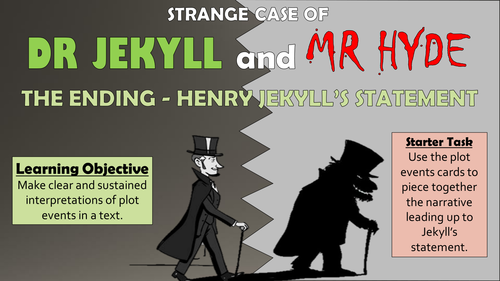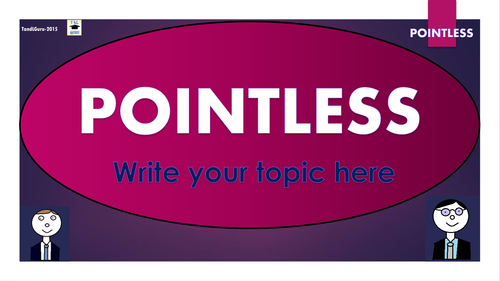
3k+Uploads
1921k+Views
2248k+Downloads
Pedagogy and professional development

Frankenstein: Shelley's Description of the Monster!
This lesson aims to improve students’ understanding of the descriptive language used to depict the monster in Chapter 5 of Mary Shelley’s horror novel 'Frankenstein.' The lesson places a particular focus upon the descriptive language devices employed by Shelley, in order to create a clear image of the monster’s appearance in the reader's mind, and also to describe Victor’s strong reaction to his creation. By the end of the lesson, students demonstrate an ability to make sustained and original interpretations of the language used by the author.
The lesson follows a step-by-step learning journey, in which children learn through:
- Considering how their preconceptions about the monster have been influenced by modern media and representations;
- Read and understand a key extract from the beginning of chapter 5 - the point at which the monster comes to life;
- Infer and interpret the key developments of the extract, including Frankenstein's changing feelings and the monster's ambiguous actions;
- Identifying and analysing some of the key descriptive devices used by Shelley to create an image of the monster;
- Analysing the effect of the descriptive devices upon the reader;
- Peer assessing each other's learning attempts.
Included is:
- Whole lesson PowerPoint - colourful and substantial; (including an animated Frankenstein's monster to guide them through the lesson);
- Descriptive devices worksheet (and a teacher answer sheet);
- Extract from the beginning of Chapter 5;
- Inferring and Interpreting worksheet;
- Analysis template with success criteria for creating well-structured responses;
- Comprehensive lesson plan.
There are also opportunities for group learning, peer assessment, and whole class discussion. This was originally taught to middle-ability year 9/10 groups, but can easily be differentiated for groups of different ages and abilities.
All images are licensed for commercial use, and image rights are listed on the last page of the presentation.

Macbeth: Lady Macbeth
This engaging and interesting lesson aims to improve students’ understanding of one of the key characters in William Shakespeare’s Macbeth: Lady Macbeth. In particular, they learn to make insightful interpretations about the character, and are enabled to draw links between Lady Macbeth and their knowledge of women in Shakespearean times.
The lesson utilises a range of tasks, that require students to be visual and interactive learners. It follows this learning journey:
- Inferring key information about the character of Lady Macbeth from picture clues;
- Identifying and ordering the key events in the text in which Lady Macbeth is involved;
- Understanding her role in the rise and downfall of Macbeth;
- Comparing and contrasting between her character and the expected role of women at the time the play was written;
- Analysing Shakespeare's development of Lady Macbeth as a key character throughout the text;
- Evaluating the learning in the lesson.
Included in this resource pack are:
- A well-presented, thorough, and informative, whole-lesson PowerPoint presentation;
- Resources for the sequencing activity, detailing Lady Macbeth's numerous actions throughout the play;
- A template to help scaffold the main task, complete with P.E.E instructions;
- A comprehensive teacher guidance form/lesson plan to assist delivery.
All images in this resource are licensed for commercial use, and are cited on the final slide of the lesson presentation.

Similes and Metaphors in Popular Music!
This interesting and highly stimulating lesson enables students to demonstrate a developed and sustained understanding of the effect of figurative language in popular music texts. In particular, students learn to explore the meanings behind similes and metaphors across songs from a range of genres, considering the effect upon the whole text and the intended audience. As one would expect, Students love learning about similes and metaphors through popular music, and this lesson can really help to open students' eyes to how language can be crafted for effect. This has numerous benefits in later poetry and descriptive writing lessons.
The lesson follows a clear, logical, bite-size learning journey, which guides students towards differentiated learning objectives. Over the course of this journey, they become able to:
- Define and identify similes and metaphors;
- Explain the similarities and differences between songs and poetry;
- Observe and listen to several examples of similes and metaphors in popular music examples;
- Understand and analyse the effect of similes and metaphors upon meanings and the reader;
- Apply their knowledge of why similes and metaphors are used to a range of contexts and musical genres;
- Collaborate and present their key findings about similes and metaphors in songs to their classmates;
- Self-assess their learning attempts.
This resource pack includes:
- A visually engaging whole-lesson PowerPoint presentation;
- Link to an online compilation video of similes and metaphors in popular music;
- 3 x lyrics analysis worksheets of varying difficulties (Katy Perry, Train, and Florence and the Machine - all clean)
- A detailed lesson plan, complete with what the teacher and students should aim to achieve at each stage of the lesson.
All images are licensed for commercial use, and are cited on the final slide of the PowerPoint.

New GCSE English Language Reading: 19th Century Non-Fiction
These informative and engaging resources enable students to build the skills needed to interpret and analyse 19th Century non-fiction texts. This will aid students through the new Paper 2 Section A of GCSE English Language - for which they need to become confident readers of 19th, 20th, and 21st Century non-fiction texts. These resources give students a strong foundation of knowledge of features of non-fiction texts in the 19th Century, using newspaper stories from the time based on 'Jack the Ripper' as the predominant examples. There are easily enough resources for at least two lessons within this resource pack.
Students learn through the following tasks:
- Inferring and deducing contextual knowledge through an interactive starter task;
- Understanding the features of London in 1888 through a video introduction;
- Building close reading skills through a study of a non-fiction extract about Jack the Ripper;
- Answering exam-style questions interpreting and inferring the key meanings in the text;
- Using models and templates to write extended analysis responses about the language used in the non-fiction extract;
- Peer assessing their partners' learning attempts.
The following resources are provided:
- Engaging and colourful step-by-step PowerPoint;
- Jack the Ripper newspaper extract;
- Teacher lesson guidance;
- Interpretation worksheet;
- Analysis worksheet;
- Writing to analyse.
All images are licensed for commercial use, and are cited on the final slide of the PowerPoint.

Anne Frank - Diary of a Young Girl - KS3 Comprehension Activities Booklet!
This resource booklet contains a wide range of age-appropriate, engaging, and meaningful comprehension activities for use throughout the reading of Anne Frank's 'Diary of a Young Girl.' Teachers have found them particularly useful in comprehension or guided reading sessions. They are perfect for aiding the progress of children towards meeting the KS3 expectations within the new National Curriculum framework. Children have found these resources extremely engaging, and for teachers there is explicit information within each task regarding which comprehension strands the task is designed to demonstrate. They also relate to key extracts, characters, and themes from the story, ensuring that children gain a deep understanding of the text.
Activities within the booklet include:
- 'Context: The Holocaust' - to enable students to demonstrate that they can: 'Know the purpose, audience and context of the writing and drawing on this knowledge to support comprehension.'
- 'Anne's Description - The Annex' - to enable students to demonstrate that they can: 'Know how language, including figurative language, vocabulary choice, grammar, text structure and organisational features, present meaning.'
- 'Otto Frank and 'Peter van Daan' - to enable students to demonstrate that they can: 'Study setting, plot, and characterisation, and the effects of these.'
- 'Vocabulary Inspector' - to enable students to demonstrate that they can: 'Learn new vocabulary, relating it explicitly to known vocabulary and understanding it with the help of context and dictionaries.'
Plus many, many more activities (the booklet is 21 pages in length!) I've also added it as a PDF in case the formatting differs on your computer.
All images are licensed for commercial use, and are cited on a separate document (included).

Learning Walk/ Teacher Development Checklists
These comprehensive checklists have been created to aid school leaders when performing learning walks with a particular focus e.g. questioning, differentiation, etc. Clearly structured and organised, they present a central idea surrounded by a breakdown of a number of its key components.
For the user, this layout provides a simple reference list of each of the desirable skills, categorised appropriately. The checklists also provide an alternative to regular feedback methods, which often focus too heavily on the standard or ‘judgement’, as opposed to being a developmental tool.
Alternatively, these are really handy for teachers looking to develop their practice in the key teaching areas listed below. Included in the pack are checklists for:
-Questioning
-Differentiation
-Utilising Resources (including support staff)
-Engagement
-Building Literacy Skills
-Planning and Expectations
-Building Learning Power
-A blank template for you to design your own based upon your own focus
Note: The checklists offer a range of desirable strategies that teachers should look to implement over time - it would be damaging to expect teachers to utilise each of these strategies in every lesson!
Many Thanks

A View from the Bridge: Context of Italian American Brooklyn
This interesting and highly-stimulating lesson enables students to make clear and sustained inferences and interpretations about the context and themes in Arthur Miller’s A View from the Bridge. In particular, students engage analytically with Alfieri’s opening monologue, demonstrating an understanding of what it reveals about Italian American culture and community at the time.
The lesson follows a clear, logical, bite-size learning journey, which guides students towards differentiated learning objectives. Over the course of this journey, they become able to:
- Understand the relevance of Brooklyn Bridge, both literally and figuratively;
- Understand the relevance of Arthur Miller's life and influences;
- Read and understand Alfieri's opening monologue, in which the geographical, social, and historical context is set, and infer and interpret the key information provided;
- Understand the key term 'Omerta', and apply codes of honour to their own contexts;
- Analyse Alfieri's opening monologue in terms of the key information it provides the audience with about context and community;
-Peer assess each other's learning attempts.
This resource pack includes:
- A visually engaging whole-lesson PowerPoint presentation;;
- Paper copies and online links to the extract needed for the lesson (Alfieri's opening monologue);
- Cards for application activity;
- Interpretations and inferences worksheet (including answer sheet for teachers);
- A logically scaffolded essay template;
- A detailed lesson plan, complete with what the teacher and students should aim to achieve at each stage of the lesson.
All images are licensed for commercial use, and are cited on the final slide of the PowerPoint.

An Inspector Calls: The Context of the Play
These interesting and engaging resources enable students to build their understanding of the context of J.B. Priestley’s play ‘An Inspector Calls.’ In particular, students learn how to make clear and appropriate links between the social and historical context and the play itself. This gives students a really stable knowledge-base from which to make inferences and interpretations about other parts of the play.
The lesson follows a clear, logical, bite-size learning journey, which guides students towards differentiated learning objectives. Over the course of this journey, they become able to:
- Recall the main events that occurred between 1912 and 1945, through an interactive group activity;
- Remember some key information about J.B Priestley and his beliefs;
- Read and understand the opening of the play;
- Make links between the opening of the play and the historical context - both in term of when the play was set, and when it was written;
- Analyse how Priestley links historical context to his characters, in order to get his messages across to the audience;
-Peer/self-assess learning attempts.
This resource pack includes:
- A visually engaging whole-lesson PowerPoint presentation;
- A clear and interesting worksheet for the development task;
- The opening of the text for students to read and interpret;
- Context information cards for the card-sorting game;
- A detailed lesson plan, complete with what the teacher and students should aim to achieve at each stage of the lesson.
All images are licensed for commercial use, and are cited on the final slide of the PowerPoint.
Bundle Sale

Macbeth Huge Bundle!
THIS BUNDLE CONTAINS ALL OF THE MACBETH LESSONS, IN ADDITION TO THE COMPREHENSION ACTIVITY BOOKLET, THE MACBETH KNOWLEDGE ORGANISER, AND THE POINTLESS GAME!
This engaging, varied, and informative scheme of learning is designed to help students gain understanding, assessment skills, and key interpretations of William Shakespeare’s ‘Macbeth.’ Made up of a wide-range of interesting and exciting lessons, students should complete this scheme having gathered vital skills in: interpreting the significant meanings of the text, understanding the writer’s ideas within the text, analysing key characters, settings, and themes, and understanding Shakespeare’s language devices.
Stimulating, visual, and easily adaptable, these lessons provide suggested learning objectives and outcomes for students of a wide-range of abilities - The vast majority of tasks are differentiated to allow for different abilities and needs in your classroom. Each lesson loosely follows this logical learning journey to ensure that students learn in bite-size steps:
- Engaging
- Defining/ Understanding
- Identifying/Remembering
- Analysing/ Creating
- Peer or self evaluating.
All of the lessons are interactive, employ a variety of different teaching and learning methods and styles, and are visually-engaging. Resources, worksheets, and lesson plans are all provided.

A View from the Bridge: Greek Tragedy - Eddie's Downfall!
This interesting and highly-stimulating lesson students to demonstrate a developed, sustained understanding of the structural features of the Greek Tragedy which are utilised in Arthur Miller’s A View from the Bridge. In particular, students engage analytically with Eddie’s ‘hamartia’ and catastrophic downfall at the end of Act II. Students examine how Eddie’s role as a tragic hero, his fatal flaw, and the sense of fate which runs throughout, mirrors the features of Greek Tragedies.
The lesson follows a clear, logical, bite-size learning journey, which guides students towards differentiated learning objectives. Over the course of this journey, they become able to:
- Define and identify the features of Greek Tragedies;
- Understand Miller's views towards Greek Tragedies, and his intentions for writing the play in this form;
- Identify the features of Greek Tragedy in A View from the Bridge;
- Critically engage with text as a Greek Tragedy, considering how Eddie's downfall is constructed by his fatal flaws, hamartia, and catastrophe;
-Peer assess each other's learning attempts.
This resource pack includes:
- A visually engaging whole-lesson PowerPoint presentation;;
- Paper copies and online links to the extract needed for the lesson (end section of Act Two);
- Greek Myths Definitions Cards;
- Greek Myths worksheet (including answer sheet for teachers);
- A logically scaffolded essay template;
- A detailed lesson plan, complete with what the teacher and students should aim to achieve at each stage of the lesson.
All images are licensed for commercial use, and are cited on the final slide of the PowerPoint.
Bundle Sale

Of Mice and Men Huge Bundle!
THIS BUNDLE CONTAINS ALL OF THE OF MICE AND MEN LESSONS, THE COMPREHENSION BOOKLET, THE KNOWLEDGE ORGANIZER AND THE POINTLESS GAME!
This engaging, varied, and informative scheme of learning is designed to help students gain understanding, assessment skills, and key interpretations of John Steinbeck’s Of Mice and Men. Made up of a wide-range of interesting and exciting lessons, students should complete this scheme having gathered vital skills in: interpreting the significant meanings of the text, understanding the writer’s ideas within the text, identifying the traits of key characters, settings, and themes, and relating the text to its social and historical context.
Stimulating, visual, and easily adaptable, these lessons provide suggested learning objectives and outcomes for students of a wide-range of abilities - The vast majority of tasks are differentiated to allow for different abilities and needs in your classroom. Each lesson loosely follows a logical learning journey to ensure that students learn in bite-size steps:
- Engaging
- Defining/ Understanding
- Identifying/Remembering
- Analysing/ Creating
- Peer or self evaluating.
All of the lessons are interactive, employ a variety of different teaching and learning methods and styles, and are visually-engaging. Resources, worksheets, and lesson plans are all provided. There is also a fun ‘Pointless’ Game included, to test your students’ knowledge of the text!

A View from the Bridge: The Lifting of the Chair Scene! (Exploring Miller's dramatic devices)
This interesting and highly-stimulating lesson enables students to demonstrate a developed, sustained understanding of the dramatic devices utilised in the ‘lifting of the chair’ scene in Arthur Miller’s A View from the Bridge. In particular, students engage analytically with Miller’s use of atmosphere, dramatic tension, dramatic irony, and stage directions throughout the scene.
The lesson follows a clear, logical, bite-size learning journey, which guides students towards differentiated learning objectives. Over the course of this journey, they become able to:
- Understand the key term 'masculinity' and how it affects the behaviour of different characters;
- Read and understand the chair-lifting scene at the end of Act One, making key interpretations and inferences;
- Define and understand the dramatic devices: dramatic devices, dramatic irony, atmosphere, and stage directions.
- Critically engage with Miller's use of dramatic devices at the end of the Act One, including the events leading up to the chair lifting section.
-Peer assess each other's learning attempts.
This resource pack includes:
- A visually engaging whole-lesson PowerPoint presentation;;
- Paper copies and online links to the extract needed for the lesson (end section of Act One);
- Dramatic Devices Cards;
- Dramatic Devices worksheet (including answer sheet for teachers);
- A logically scaffolded essay template;
- A detailed lesson plan, complete with what the teacher and students should aim to achieve at each stage of the lesson.
All images are licensed for commercial use, and are cited on the final slide of the PowerPoint.

Year 2 Guided Reading Comprehension Activities Booklet! (Aligned with the New Curriculum)
Now with PDF version included! This resource booklet contains a wide range of age-appropriate, engaging, and meaningful comprehension activities for use in guided reading sessions. They are perfect for aiding the progress of children towards meeting the Year 2 expectations within the new National Curriculum framework. Children love learning from these resources, whilst they are also of great use to teachers, as there is explicit information within each task regarding which comprehension strands the task is designed to demonstrate. They are also generic enough to ensure that they are appropriate for use with all texts.
Activities within the booklet include:
- Word Witch - to enable students to demonstrate that they can: 'Spot when a word has been read wrongly by following the sense of text;'
- Scary Stepping Stones - to enable students to demonstrate that they can: 'Enjoy reading and discussing the order of events in books and how items of information are related;'
- Poets' Got Talent - to enable students to demonstrate that they can: 'Enjoy reading poems and know some by heart. Say what you like or don’t like about a poem;'
- Story Mountain - to enable students to demonstrate that they can: 'Enjoy reading and discussing the order of events in books and how items of information are related.'
Plus many, many more activities (the booklet is over 20 pages in length!)
All images are licensed for commercial use, and are cited on a separate document (included.)

A View from the Bridge Comprehension Activities Booklet!
This resource booklet contains a wide range of age-appropriate, engaging, and meaningful comprehension activities for use throughout the reading of Arthur Miller’s ‘A View from the Bridge.’ Teachers have found them particularly useful in exam revision, comprehension tasks, or guided reading sessions. They are perfect for aiding the progress of students towards meeting the KS4 expectations within the new National Curriculum framework - this makes the tasks suitable for all examining bodies. Students have found these resources extremely engaging, and for teachers there is explicit information within each task regarding which comprehension strands the task is designed to demonstrate. They also relate to key extracts, characters, and themes from the story, ensuring that students gain a deep understanding of the text.
Activities within the booklet include:
- ‘Context: 1950s America’ - to aid students with ‘Drawing on knowledge of the purpose, audience and context of the writing, including its social, historical and cultural context and the literary tradition to which it belongs, to inform evaluation;’
- ‘Miller’s Description’ - to aid students with ‘Analysing a writer’s choice of vocabulary, form, grammatical and structural features, and evaluating their effectiveness and impact;’
- ‘Eddie’ - to aid students with ‘Seeking evidence in the text to support a point of view, including justifying inferences with evidence;’
- ‘Editing the Play’ - to aid students with ‘Making an informed personal response, recognising that other responses to a text are possible and evaluating these.’
Plus many, many more activities (the booklet is around 30 pages in length!) I’ve also added it as a PDF in case the formatting differs on your computer.
All images are licensed for commercial use, and are cited on a separate document (included).
Bundle Sale

Holiday Fun Activities Bundle!
Included in this bundle are hours of fun, interactive, and productive activities that have been tried and tested with hundreds of happy children. Not only are the activities engaging, they also enable young people to develop their key skills in areas as varied as: Literacy, Numeracy, Science, Art and Design, PSHE, and Speaking and Listening.
Included within the bundle are the following popular resources:
- Murder Mystery Investigation: Students use exhibits, maps, evidence, and budgeting skills in order to solve a murder mystery case;
- Fantasy Football Club Group Project: Students design and resource their own football team from scratch, using a limited budget and selection of classic and modern footballers;
- Stating Your Case for the World’s Greatest Sportsperson - Students use their researching, persuasive writing, and speaking and listening skills to argue the case for the best sportsperson of all time;
- Space Mission: Find Us A New Earth! - Students are given an imaginative scenario and real-life information about the current most hospitable exo-planets, and must use their scientific and literacy skills to build a case for the next planet humans should inhabit;
- Crazy Animal Limericks Anthology - Loads of fun animal limericks for students to read, and comprehension/ creative tasks for them to complete.
All that you have to do is print and go, everything that you need for these resources (including teacher guidance) is provided.
All images are licensed for commercial use, and are cited on the final slides of the presentations.
Bundle Sale

Teaching and Learning CPD Bundle!
These teaching and learning CPD sessions offer engaging and original approaches to introducing or revisiting a range of effective pedagogical strategies. Grounded in educational research, these sessions are interactive, well-structured, and have been successfully tried and tested.
The aim of each teaching and learning CPD session is to develop the knowledge, skills, and strategies needed in order to utilise in practice in each key area, and as an aid in achieving these aims, the trainer is supported with:
-Colourful, engaging, and comprehensive PowerPoint presentations;
-Videos for analysis of key techniques;
-A wide range of interactive resources for CPD activities;
-Instructions and plans to assist delivery.
All images and videos are licensed for commercial use, and are cited on the final slide of each PowerPoint.

Space Mission: Find us a New Earth!
The year is 2086, and the students are needed for a special mission!
This space mission has been designed to provide students with a fun and interesting group challenge, whilst also building key skills in critical thinking and collaboration, and essential knowledge for Science, English, and Mathematics.
Students are placed in a scenario in which Earth is no longer habitable, and humans must seek to move to another planet in the Universe. Compiled for them is information on each of the potentially most habitable planets that are known to man (these are the real planets that have been confirmed by NASA and other agencies as having the most potential for life). In reading the key information, students will be drawing upon their knowledge of Science terminology, and will need to make some Maths calculations to work out implications of living on different planets.
What will become clear fairly quickly is that none of the potential planets are perfect, and they must use reasoned judgements to determine which of them have cons that could perhaps be overcome. They then present their ideas, using clear and articulate speaking and listening skills, and write up their report, using appropriate written communication (a scaffold is provided to frame this).
Everything is provided for you to download, print, and teach:
- A comprehensive, whole-activity PowerPoint that guides the students through the mission;
- Detailed and colourful information sheets on each of the contender planets for being the next Earth (these include links to amazing websites that can provide the children with more information);
- A 'Pros and Cons' scaffold, to help students record their findings;
- An information sheet on the 'habitable zone' around stars;
- A scaffold for writing up findings;
- Sorting cards for help with determining the key features of habitable planets;
- Full teacher guidance.
Considering the time and effort that it took to create these resources, I think that they offer exceptional value. Whenever I have used this activity before, it has taken at least 2-3 lessons, including the introduction, starter challenge, main mission, presentations, and write-up. I originally have used this with mid-ability Year 6,7, and 8 groups, but colleagues have easily adapted it for students across key stages 2-4.
All images have been cited at the end of the PowerPoint presentation and are licensed for commercial use.

Ozymandias - Percy Bysshe Shelley
This engaging, comprehensive lesson provides an interesting and highly-informative study of Percy Bysshe Shelley's power and conflict poem: 'Ozymandias.' Throughout the lesson, students gain a detailed understanding of the poem, with a particular focus upon the content, language, and structural features employed by Shelley. By the end of the lesson, students demonstrate their knowledge of the text analytically, through assured, appropriate, and sustained interpretations.
The lesson follows a step-by-step learning journey, in which children learn through:
- Defining the key concept of power, and considering its role and implications in man's actions;
- Securing contextual understanding of both Ozymandias the ruler, and Percy Bysshe Shelley the poet;
- Reading and interpreting the poem, using a provided line-by-line analysis, and interactive group activities;
- Developing their understanding through inferring and analysing key language and structural choices;
- Analysing how the theme of power is explored through Shelley's content, language, and structure;
- Peer assessing each other's learning attempts.
Included is:
- Whole lesson PowerPoint - colourful and substantial; (including hyperlinks to informative and engaging videos)
- Copy of poem;
- Content, language and structure mind map;
- Deeper thinking worksheet;
- Analysis template with success criteria for creating well-structured responses;
- Comprehensive lesson plan.
There are also opportunities for group learning, peer assessment, and whole class discussion. This was originally taught to middle-ability year 9/10 groups, but can easily be differentiated for groups of different ages and abilities.
All images are licensed for commercial use, and image rights are listed on the last page of the presentation.

Dr Jekyll and Mr Hyde: The Ending - Henry Jekyll's Statement
This engaging and informative lesson enables students to make sustained and insightful interpretations of the final chapter of ‘Strange Case of Dr Jekyll and Mr Hyde.’ In particular, students interpret and analyse the key events of Dr Jekyll’s closing statement, using relevant supporting textual evidence.
The lesson follows a step-by-step learning journey, in which children learn through:
- Establishing the sequence of events leading up to Jekyll's statement;
- Reading and comprehending the final chapter;
- Securing understanding of the chapter through a fun, interactive quiz;
- Creating a storyboard of the events to demonstrate their understanding of plot;
- Analysing the key events of the chapter, using appropriate textual evidence;
- Peer assessing each other's learning attempts.
Included is:
- Whole lesson PowerPoint - colourful and comprehensive;
- Extract from the final chapter;
- Cards for card-sorting activity;
- Storyboard for the development task;
- Analysis template with success criteria for creating well-structured responses;
- Comprehensive lesson plan.
There are also opportunities for group learning, peer assessment, and whole class discussion. These resources were originally taught to GCSE students, but with subtle adaptations they have also been used with KS3 and A Level Students.
All images are licensed for commercial use, and image rights are listed on the last page of the presentation.

A View from the Bridge Pointless Game! (and blank template to make your own games!)
Based on the popular game show 'Pointless', this resource is perfect for use as a whole lesson resource, enrichment option, or revision tool. Editable, so that you can change to any other topic or change questions. (I've also added a blank template so that you can make your own games from scratch). Containing almost 30 slides of sound clips, engaging visuals, and suitably challenging questions, this resource is effective at both promoting engagement and enhancing learning. There are several full rounds of questions to build or revisit knowledge of characters, plot, and themes in A View from the Bridge:
Round 1. The characters in A View from the Bridge (takes approx 10 mins)
Round 2. Quotations from the text (takes approx 15 mins)
3. Settings, themes, and objects (takes approx 15 mins)
4. Themes in A View from the Bridge (takes approx 10 mins)
The nature of this game ensures that the resource can challenge students of all levels.

